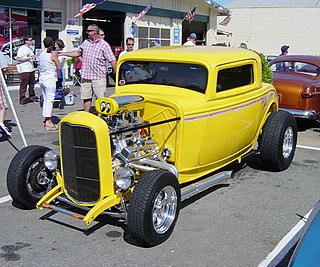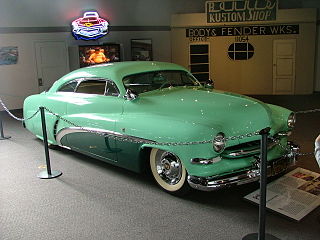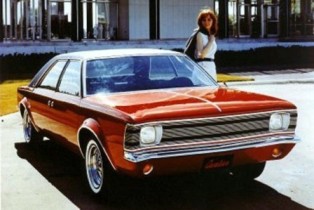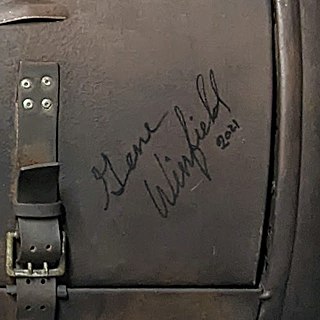
The term 1932 Ford may refer to three models of automobile produced by Ford Motors between 1932 and 1934: the Model B, the Model 18, and the Model 40. These succeeded the Model A. The Model B had an updated four-cylinder engine and was available from 1932 to 1934. The V8 was available in the Model 18 in 1932, and in the Model 40 in 1933 & 1934. The 18 was the first Ford fitted with the flathead V-8. The company also replaced the Model AA truck with the Model BB, available with either the four- or eight-cylinder engine.

Hot rods are typically American cars that might be old, classic, or modern and that have been rebuilt or modified with large engines optimized for speed and acceleration. One definition is: "a car that's been stripped down, souped up and made to go much faster." However, there is no definition of the term that is universally accepted and the term is attached to a wide range of vehicles. Most often they are individually designed and constructed using components from many makes of old or new cars, and are most prevalent in the United States and Canada. Many are intended for exhibition rather than for racing or everyday driving.

The AMC AMX is a two-seat GT-style muscle car produced by American Motors Corporation from 1968 through 1970. As one of just two American-built two-seaters, the AMX was in direct competition with the one-inch (2.5 cm) longer wheelbase Chevrolet Corvette, for substantially less money. It was based on the new-for-1968 Javelin, but with a shorter wheelbase and deletion of the rear seat. In addition, the AMX's rear quarter windows remained fixed, making it a coupe, while the Javelin was a true two-door hardtop.

George Barris was an American designer and builder of Hollywood custom cars. Barris designed and built the Hirohata Merc. Barris's company, Barris Kustom Industries, designed and built the Munster Koach and DRAG-U-LA for The Munsters; and the 1966 Batmobile for the Batman TV series and film.

Kustom Kulture is the artworks, vehicles, hairstyles, and fashions of those who have driven and built custom cars and motorcycles in the United States of America from the 1950s through today. It was born out of the hot rod culture of Southern California of the 1960s.

A rat rod, as usually known today, is a custom car with a deliberately worn-down, unfinished appearance, typically lacking paint, showing rust, and made from cheap or cast-off parts. These parts can include non-automotive items that have been repurposed, such as a rifle used as a gear shifter, wrenches as door handles, or hand saws as sun visors. Whether or not so appointed, the rat rod uniquely conveys its builder’s imagination.

A custom car is a passenger vehicle that has been either substantially altered to improve its performance, often by altering or replacing the engine and transmission; made into a personal "styling" statement, using paintwork and aftermarket accessories to make the car look unlike any car as delivered from the factory; or some combination of both. A desire among some automotive enthusiasts in the United States is to push "styling and performance a step beyond the showroom floor - to truly craft an automobile of one's own." A custom car in British according to Collins English Dictionary is built to the buyer's own specifications.

A lead sled is a standard production automobile with a body heavily modified in particular ways(see below); especially, though not exclusively, a 1949, 1950, or 1951 model year Ford 'Shoebox' or Mercury Eight car. In the name, "lead" refers to the use of lead as a bodyfiller in early days, and "sled" refers to the lowering of the vehicle, giving these vehicles the appearance that they were "slip sliding" down the highway.

The Mercury Eight is an automobile that was marketed by the Mercury division of Ford between 1939 and 1951. The debut model line of the Mercury division, Ford slotted the full-size Mercury Eight between the Ford Deluxe model lines and the Lincoln. In total, Ford assembled three generations of the Eight.

The AMC Cavalier was a compact concept presented by American Motors (AMC) in 1965, noted for symmetrical elements of its design and its interchangeable body parts.

The AMC AMX-GT is a concept car that was developed by American Motors Corporation (AMC) for the 1968 show car circuit. The design of the grand touring-type rear-wheel-drive pillarless coupe of monocoque construction with two doors and a truncated rear end treatment was influenced by AMC stylist Dick Teague.

Kustoms are modified cars from the 1930s to the early 1960s, done in the customizing styles of that time period. The usage of a "K" for "Kustom" rather than a "C", is believed to have originated with George Barris.

The Munster Koach is the family car that was used in the television series, The Munsters. The show's producers contracted George Barris to provide the Koach. Barris paid show car designer Tom Daniel $200 to design the car, and had it built at Barris Kustoms, first by Tex Smith, but finished by Dick Dean, his shop foreman at the time. The Munster Koach appeared in over twenty episodes throughout the series' two-year run, and was also seen in Munster, Go Home! using different wheels. Tom Daniel's original drawing of the Munster Koach had it supercharged with a hood scoop and thin, round disc lights. Barris chose the ten-carburetor setup with the ten air horns and lantern lights.
Dick Dean, born Richard Dean Sawitskas [Sa-WITS-kas], was an American automobile designer and builder of custom cars. Father of Keith Dean.

The Hirohata Merc is a 1950s custom car, often called "the most famous custom of the classic era". Setting a style and an attitude, it had a "momentous effect" on custom car builders, appeared in several magazines at the time and has reappeared numerous times since, earning an honorable mention on Rod & Custom's "Twenty Best of All Time" list in 1991. The impact may be measured by the fact that, after more than fifty years and numerous owners, it is still known as "the Hirohata Merc".

Gene Winfield is an American automotive customizer and fabricator. In the mid-1960s, his designs caught the attention of the film community, resulting in a large body of his work appearing on screen, including in the iconic 1982 film Blade Runner.
Ala Kart is a custom car, a customized 1929 Ford Model A roadster pickup, built by George Barris, Richard Peters, and Mike "Blackie" Gejeian in 1957. Originally owned by Peters, it is a two-time winner of the Grand National Roadster Show "America's Most Beautiful Roadster" (AMBR) trophy and Hot Rod cover car in October 1958. Featured in hundreds of car shows, Ala Kart has won more than 200 trophies. It has also made numerous appearances in movies, usually in the background of drive-in shots, and dozens of magazine articles since. It is considered by many to be "one of the most iconic hot rods ever built."
Bill Cushenbery was an American car customizer, show car builder, and model kit designer. Cushenbery was a major influence on the look of custom cars and the customizing industry in general. In addition to building his own designs, he is noted for having helped George Barris create the Batmobile car featured in the 1966–1968 Batman television series.
El Matador is a custom car built by Bill Cushenbery during 1959–1961. It was his first show car.

Gerald Douglas "Bo" Huff was an American custom car designer and an influential figure in the American Kustom Kulture and hot rod movement. He was known as the "Rockabilly King" in the American custom car scene for his promotion of Kustom Kulture lifestyle, rat rods, and custom cars, and was identified as one of the top 20th and early 21st century American custom car designers.


















